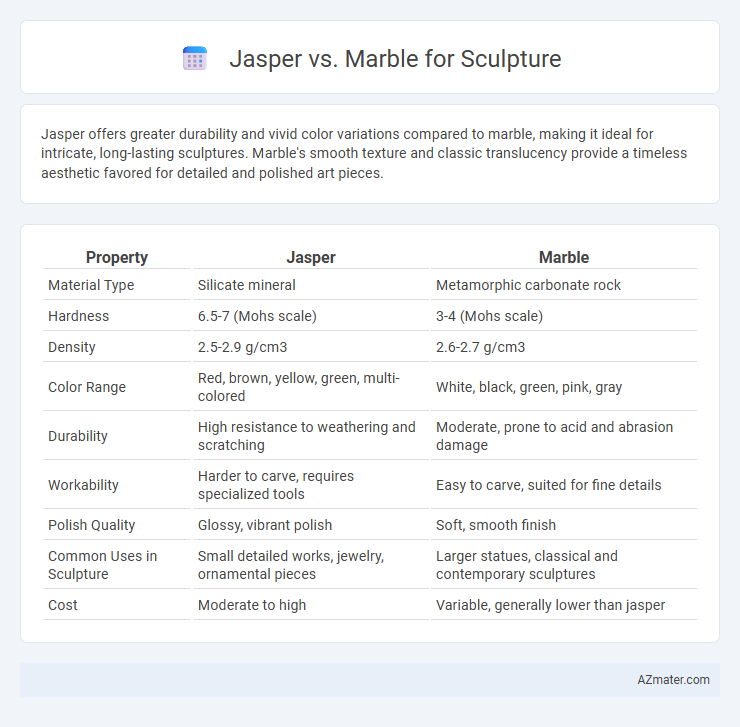Jasper offers greater durability and vivid color variations compared to marble, making it ideal for intricate, long-lasting sculptures. Marble's smooth texture and classic translucency provide a timeless aesthetic favored for detailed and polished art pieces.
Table of Comparison
| Property | Jasper | Marble |
|---|---|---|
| Material Type | Silicate mineral | Metamorphic carbonate rock |
| Hardness | 6.5-7 (Mohs scale) | 3-4 (Mohs scale) |
| Density | 2.5-2.9 g/cm3 | 2.6-2.7 g/cm3 |
| Color Range | Red, brown, yellow, green, multi-colored | White, black, green, pink, gray |
| Durability | High resistance to weathering and scratching | Moderate, prone to acid and abrasion damage |
| Workability | Harder to carve, requires specialized tools | Easy to carve, suited for fine details |
| Polish Quality | Glossy, vibrant polish | Soft, smooth finish |
| Common Uses in Sculpture | Small detailed works, jewelry, ornamental pieces | Larger statues, classical and contemporary sculptures |
| Cost | Moderate to high | Variable, generally lower than jasper |
Introduction to Jasper and Marble in Sculpture
Jasper, a dense and opaque variety of chalcedony, offers sculptors vibrant colors and intricate natural patterns that enhance artistic details in sculptures. Marble, a metamorphic rock composed primarily of calcite, is prized for its smooth texture and ability to achieve fine polish, making it a classical favorite for lifelike and elegant sculptures. Both materials provide distinct aesthetic qualities, with jasper valued for its unique color variations and marble for its timeless sophistication in sculptural art.
Historical Significance of Jasper and Marble
Jasper, prized since ancient Egypt for its rich color variations and durability, was often used in intricate jewelry and small sculptures symbolizing protection and spiritual significance. Marble, favored by Greeks and Romans, became synonymous with classical sculpture due to its fine grain and ability to hold intricate details, embodying ideals of beauty and permanence. Both materials hold deep historical importance, with jasper associated more with ornamental and symbolic works and marble dominating monumental sculptures and architectural masterpieces.
Geological Origins: Jasper vs Marble
Jasper is a variety of chalcedony, a microcrystalline form of quartz, formed from sedimentary processes involving silica-rich fluids and often containing iron oxide impurities that give it its characteristic red, yellow, or brown colors. Marble is a metamorphic rock originating from the recrystallization of limestone or dolostone under high pressure and temperature conditions, resulting in a dense, crystalline structure primarily composed of calcite or dolomite. The geological origins of jasper impart a hard, durable surface with rich coloration ideal for intricate details, while marble's metamorphic formation yields a softer, more workable stone favored for smooth, polished sculptures.
Appearance and Aesthetic Qualities
Jasper offers a rich palette of earthy tones and intricate patterns, featuring opaque, often multicolored surfaces that enhance the naturalistic and raw visual appeal in sculptures. Marble, known for its smooth, crystalline texture and classic translucence, provides a timeless elegance with subtle veining that accentuates the refined details and polished finishes in sculptural art. The distinct visual qualities of jasper emphasize bold, organic aesthetics, whereas marble delivers a more delicate, luminous sophistication favored in traditional and contemporary sculpture.
Workability: Carving Jasper vs Marble
Jasper, a dense and hard microcrystalline quartz, poses significant challenges in carving due to its toughness and brittleness, requiring specialized tools and techniques for detailed work. Marble, a softer and more homogeneous metamorphic rock, offers superior workability with easier shaping, smoothing, and fine detailing capabilities, making it a preferred choice for sculptors seeking precision. The slower carving process of jasper limits its use to smaller, more intricate sculptures, while marble supports larger and more elaborate artistic expressions.
Durability and Longevity in Sculptures
Jasper offers remarkable durability and resistance to weathering, making it ideal for outdoor sculptures that require long-lasting preservation. Marble, while prized for its classic aesthetic and workability, is more susceptible to erosion and acid rain, which can compromise its longevity over time. Sculptors seeking enduring monuments often prefer jasper for its hardness and minimal maintenance needs compared to marble.
Artistic Applications and Styles
Jasper's rich color variations and fine-grained texture make it ideal for detailed, intricate sculptures with vibrant visual appeal, often used in small to medium-sized ornamental art pieces. Marble's smoothness and translucency lend themselves to classical and Renaissance-style sculptures, emphasizing fluid lines and lifelike forms with a timeless elegance. Artists choose jasper for bold, decorative works requiring colorful, polished finishes, while marble remains preferred for monumental sculptures demanding subtle shading and refined surface quality.
Cost and Availability Comparison
Jasper is generally more affordable than marble, with prices varying based on quality and color rarity, making it a cost-effective choice for sculptures. Marble, prized for its classic appearance and workability, tends to be more expensive due to extensive quarrying and high demand in the art world. Availability of jasper can be more stable as it is an abundant silica-based stone, while marble availability fluctuates with quarry operations and geographical constraints.
Environmental Impact of Sourcing
Jasper and marble differ significantly in environmental impact during sourcing, with marble quarrying often leading to greater landscape disruption and higher carbon emissions due to intensive extraction processes. Jasper, typically sourced from smaller, less invasive deposits, tends to have a lower ecological footprint but may involve longer transportation distances affecting overall sustainability. Prioritizing environmentally responsible quarrying practices and local sourcing can mitigate negative effects for both materials.
Choosing Between Jasper and Marble for Your Sculpture
Choosing between jasper and marble for your sculpture depends on the desired aesthetic and durability. Jasper, known for its rich, vibrant colors and hardness, offers excellent resistance to weathering, making it ideal for outdoor pieces. Marble provides a classic, smooth finish with fine grain suitable for detailed carving but is softer and more susceptible to erosion over time.

Infographic: Jasper vs Marble for Sculpture
 azmater.com
azmater.com